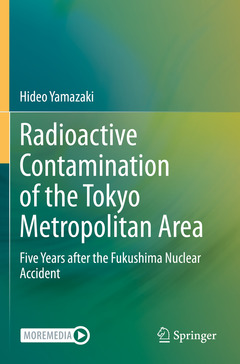Description
Radioactive Contamination of the Tokyo Metropolitan Area, 1st ed. 2020
Five Years after the Fukushima Nuclear Accident
Author: Yamazaki Hideo
Language: English
Subjects for Radioactive Contamination of the Tokyo Metropolitan Area:
Approximative price 84.39 €
In Print (Delivery period: 15 days).
Add to cartPublication date: 10-2021
249 p. · 15.5x23.5 cm · Paperback
Approximative price 116.04 €
In Print (Delivery period: 15 days).
Add to cartPublication date: 10-2020
249 p. · 15.5x23.5 cm · Hardback
Description
/li>Contents
/li>Biography
/li>Comment
/li>
This book presents the 5-year monitoring of radioactive contamination in the Tokyo metropolitan area due to the Fukushima accident, covering radiation monitoring of soil, litter, river, water, seawater, aquatic sediments, fish and shellfish, and plants in urban areas. Based on spatial and temporal data, it evaluates the environmental radiation contamination of the Tokyo metropolitan following the first nuclear accident affecting an urban area since Chernobyl. Since little is known about the contamination in Kiev city, this data is particularly valuable, offering insights into the dynamics of radioactive contamination in metropolitan areas, which are of interest in relation to the behavior of radionuclides resulting not only from nuclear accidents but also from nuclear terrorism? As such, this book will be appeal to nuclear and radiation experts, environmental administration professionals and specialists in environmental protection groups, as well as student and academics in the related fields.
Hideo Yamazaki retired as a Professor at Kindai University and is now a director of an NPO corporation on environmental conservation. He is also a peer reviewer for several academic journals.
After receiving his bachelor's degree in Nuclear Reactor Engineering, he completed his PhD degree at Kindai University with research on the dynamic analysis of heavy metal pollution in the aquatic environment using radiochemical techniques. He was also involved in developing ultra-precision pH measurement methods of geothermal power-plant hot water in Professor Henry Freiser’s laboratory at the University of Arizona.
He has received the Encouragement Award from the Japan Association for Chemical Innovation, the Academic Award and Best Paper Award from the Japan Society for Environmental Chemistry, and the Best Paper Award from the Society of Environmental Conservation Engineering.
Presents the actual situation of radioactive contamination in Tokyo metropolitan
Provides measured data of the behaviour and balance of radionuclides in urban areas
Provides comprehensive analysis of environmental radiation contamination in Tokyo city from the Fukushima accident




